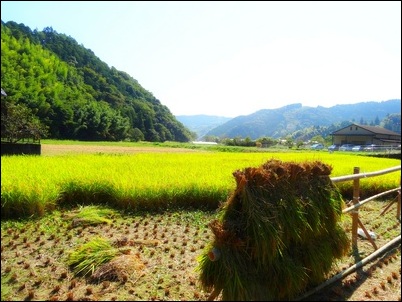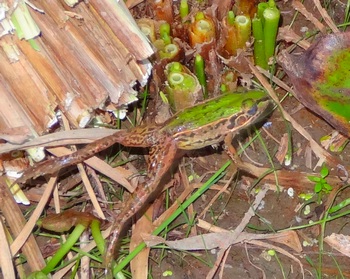What a beautiful place! On October 12th, I went to visit the Kinezuka family farm in Fujieda (maybe 45 minutes from my apartment by car) to participate in the rice harvest.
They use no agricultural chemicals, so I had imagined it would be a pretty “open-hearted” rice paddy, that there might be all sorts of surprises down among the rice stalks . . . but little did I expect that by late afternoon Mr. Kinezuka would be holding a mamushi just behind its jaw, peeling off its skin (even as it side-winded in midair) and gutting it, so that a young lady could take it back to Tokyo to dry, grind up, and sprinkle on her bowl of rice . . . or whatever she liked to sprinkle mamushi powder on. Neither did I expect that once the poisonous snake was skinned and “racked up” up on a stick and the initial excitement was over, that the guys would gather in a circle, divvy up the snake’s liver, and eat it as lustily as they would a slice of sashimi.
There were 12,637 frogs in this open-hearted rice paddy. I counted every one of them. Well, counted enough of them to make a “strong” estimate. But I’ll stand by my twelve-thousand figure . . . give or take a frog or two.
I’m no biologist and of course could see no micro-organisms, but it seemed pretty obvious: Keep the paddy chemical-free and the insects do pretty well. And that makes the frogs happy. And then you’ve got the snakes.
An open-hearted paddy also attracts a lot of interesting people. With your short-handled sickle, you whack your way down a row of rice stalks, in any direction, and before you know it you’re chatting with (or just working alongside) a filmmaker, a company man turned produce grower, a woman involved with an NPO that helps out tsunami victims in Tohoku, a young guy with a PhD in Physics, a woman who chainsaws tree stumps into attractive kitchenware.
We tied the bundles of rice stalks together with year-old rice stalks that we twisted into twine. My first fifteen or twenty bundles, I was pretty bad at twisting up a usable “rope” and tying it off. After that, I got a little better. But I don’t think any of my bundles fell apart.
We raised lines of bamboo poles to hang the rice stalks on. I’d seen–on other days, in other places–that lots of farmers used machines that cut the stalks and separated the rice from the stalks all in one go, and wondered why some folks took the time to hang out the rice to bask in the sun for a week or so–and some didn’t.
Hang the bundles with the grains of rice down, I was told, and the nutrition remaining in the stalks flows down into the grains. I tried to ask, in a mathematical sort of way, what the additional nutrition added up to, but soon was to understand it wasn’t the right question. It tastes better, I was told.
Open the heart. See what comes. In the end, you may or may not care to eat the mamushi, but you’ll have the choice. Finally, once you’ve got something–don’t rush it into the barn. Make sure it fills with all the nutrition it can.
I can imagine a writing teacher saying something like that.
Under a strong sun,
We rip sickles through rice stalks.
A thousand frogs flee.


